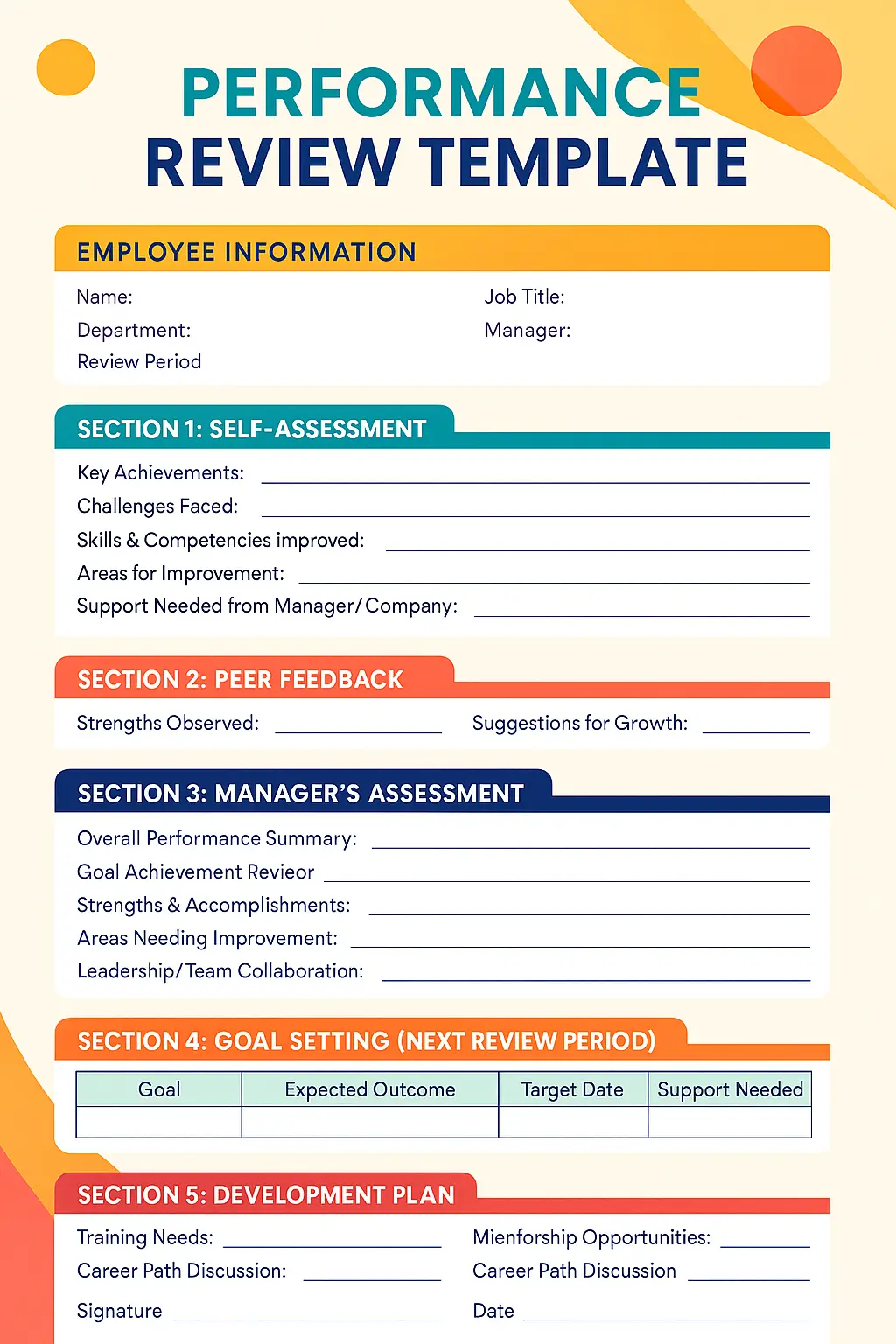Performance Review Template: Tested by Top Companies
Conducting employee performance reviews is an important part of managing any team, but without proper documentation or any performance review template, it causes many problems. Managers conduct evaluations of employees according to their own mindset. Which creates unfairness among employees. Without any proper documentation, companies face problems in many cases, like promotion and legal cases.
To solve this problem, we have studied world-top companies such as Google, Netflix, Adobe, and Apple, who have explained their performance review system in a transparent and structured way so that each employee receives fair feedback.
Based on this research and modern techniques, we have created a proven performance evaluation template that works for companies of all sizes. By using this template, you can create a fair and transparent evaluation process.
See Zelt in Action
Speak to us to learn how you can streamline performance reviews with Zelt.
What is a performance review template?
A performance review, also known as a performance appraisal or evaluation, is a formal process where a manager assesses an employee’s work performance. It provides valuable information about employee performance to managers, peers, and other stakeholders.
A performance review template is a structured document that guides managers and employees through the evaluation process, ensuring consistent and comprehensive assessments.
It helps managers by providing all the important sections needed for both the employee and the reviewer during the evaluation. A well-designed template ensures consistency and prevents unfairness or frustration among employees by providing clear feedback and the support they need to grow.

How Top Companies Conduct Performance Reviews
Every company conducts performance reviews in its own way. But the world’s top companies, like Google, Netflix, Adobe, and Apple, conduct these reviews in a very structured and transparent way. Rather than relying on yearly ratings, these companies focus on fairness and employee growth.
Let’s discuss how these companies conduct their performance reviews and how we can learn from them:
Google has a very structured and data-driven performance review system, and its main aim is to promote transparency and fairness in all processes.
- Self-Assessment: Employees analyze their own performance and check all things, such as their achievements or challenges and where there is a need for improvements.
- Peer Feedback: Colleagues provide anonymous feedback. It shows employees’ performance from multiple angles.
- Manager Evaluation: Managers assess performance based on self-assessments and peer feedback.
- Calibration Committees: Committees of different teams review the ratings to ensure consistency and fairness.
- Frequency: Google conducts reviews twice a year, allowing for timely feedback and course correction when it is needed.
This multi-layered process ensures that all the employees receive fair and detailed feedback, which supports their personal and professional growth.
Netflix
Netflix has completely eliminated traditional ratings and adopted a culture of ongoing, honest feedback.
- No Formal Ratings: Netflix doesn’t have any numeric rating system. They focus on continuous open conversations where employees and managers openly discuss performance.
- 360-Degree Feedback: Feedback comes from peers, managers, and subordinates, which offers a well-rounded perspective.
- The “Keeper Test”: Managers regularly consider whether they would fight to keep an employee; if not, they initiate open discussions about performance.
- Continuous Feedback: Performance discussions happen regularly, providing constant feedback, and employees are expected to continuously improve their work.
This informal but powerful approach promotes trust, accountability, and ongoing development.
Adobe
Adobe replaced traditional annual reviews with its innovative Check-In System, which emphasizes continuous dialogue.
- Frequent One-on-One Meetings: Managers meet regularly with employees to review progress and address concerns.
- Collaborative Goal Setting: Employees and managers work together to set realistic, achievable goals.
- Focus on Development: No numerical rankings, just constructive discussions focused on growth.
- Real-Time Adjustments: Goals can be adjusted throughout the year based on changing business needs.
Adobe’s approach creates a supportive, low-pressure environment where employees can grow without the stress of rigid rankings.
Apple
Apple’s performance review process strikes a balance between structured evaluations and fostering creativity.
- Annual Performance Reviews: Employees participate in formal reviews that assess goal achievement, innovation, and teamwork.
- Ongoing Feedback: Continuous informal feedback keeps employees aligned with expectations year-round.
- Goal-Oriented Evaluation: Reviews focus on specific, measurable goals and deliverables.
- Emphasis on Innovation: Creativity, problem-solving, and collaboration play a significant role in evaluations.
- Manager-Driven Coaching: Managers serve as active coaches, guiding employees toward both personal growth and company objectives.
By integrating creativity into structured reviews, Apple maintains high standards while nurturing innovation. This structured yet flexible approach contributes to a better employee experience across teams.
Types of performance review
There are 5 popular types of performance reviews, which are listed below:
- Simple performance reviews
- 30/60/90
- OKR
- 360
- Rating scale
Let’s discuss each of them:
Simple performance reviews
Simple performance reviews are the foundation of most of the other review types and can be performed at any time. These reviews provide more in-depth feedback than weekly check-ins and also highlight employees’ overall performance, including their achievements and places for improvement. As they are simple, it does not mean that these reviews are useless or somehow not effective.
Time-Based Performance Reviews
Time-based performance reviews, also known as 30/60/90 reviews, are especially used when a new employee joins the company or is in a probationary period.
These reviews are conducted on a monthly basis, such as after 30 days, then 60, and then 90. That’s why they are also called 30/60/90. It helps to check the performance of an employee, and the same template is used so that the data can be compared. A review will be considered good when there are improvements in the ratings of each review. These time-based reviews are not only for new employees, but they are also very useful for employees on a Performance Improvement Plan (PIP).
OKR reviews
OKR reviews mean Objectives and Key Results. They are highly effective for the positions where direct results are important, such as in marketing or sales. Measurable goals are set in this type of employee evaluation. It is to be checked in every review whether the goals of the
360 Reviews
360 Reviews are the performance reviews in which, along with the manager, all the team colleagues of the employee give their feedback. It shows the performance of employees from multiple angles because of their detailed feedback. It helps in many ways, such as exposing unfair behavior by a manager, and grudges can also be detected easily.
Rating Scales
Rating scale reviews can be used solely or can be integrated with other types of appraisal reviews to make the feedback more data-driven. These reviews are used to check whether an employee is improving their skills or declining. It helps to understand where there is a need for improvements or training. Managers usually give the performance of an employee a rating on a scale from 1 to 4.
1 = Underperformance
2 = Needs Improvement
3 = Performing better than expectations
4 = Outstanding performance
Rating scale reviews can be combined with other types of reviews, such as with simple or 30/60/90 review templates.
Conclusion
If you are using traditional ways for performance reviews, it may cause frustration and unfairness among employees. That’s why we studied the performance management processes of the world’s top companies and created a proven and tested performance review template. Implementing their strategies can help you boost productivity and drive engagement.
So don’t waste any more time and download our free performance appraisal template to transform your organization’s culture, or take it a step further with Zelt’s performance management software for a fully streamlined, automated solution.
Frequently Asked Questions
How do I write my performance review template?
A performance review template should include all the necessary information about the employee along with space for improvements, achievements, and other details. This way, you can create a performance appraisal template.


